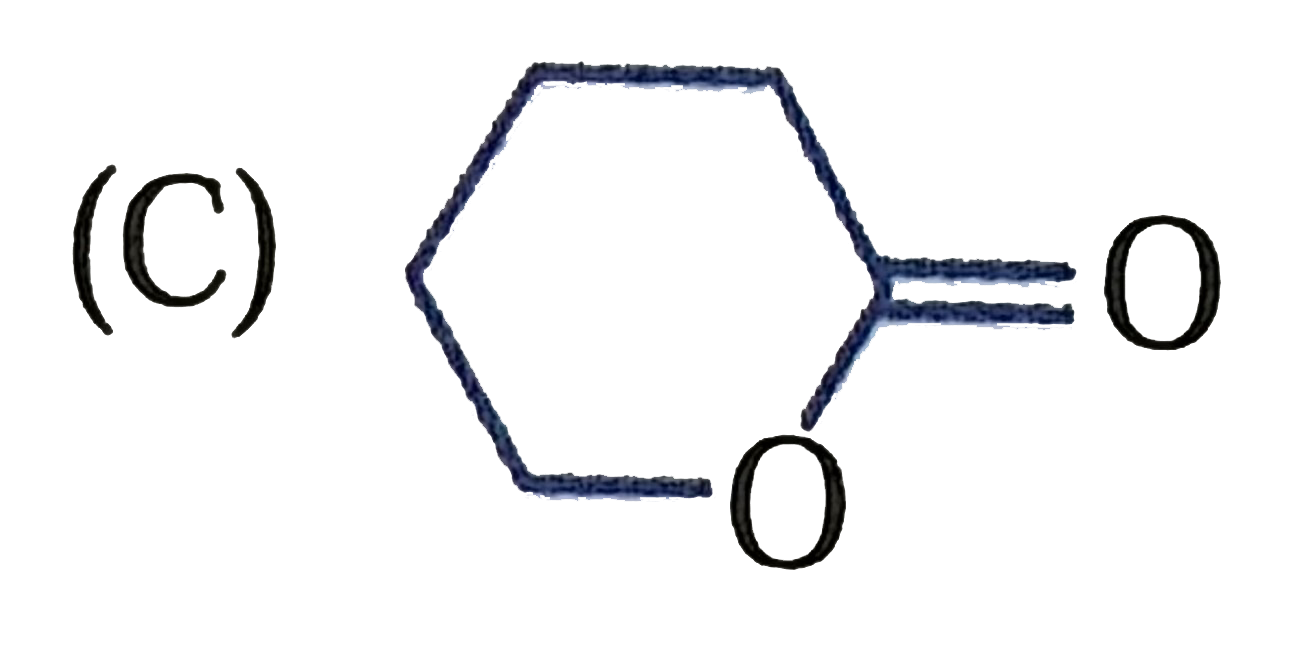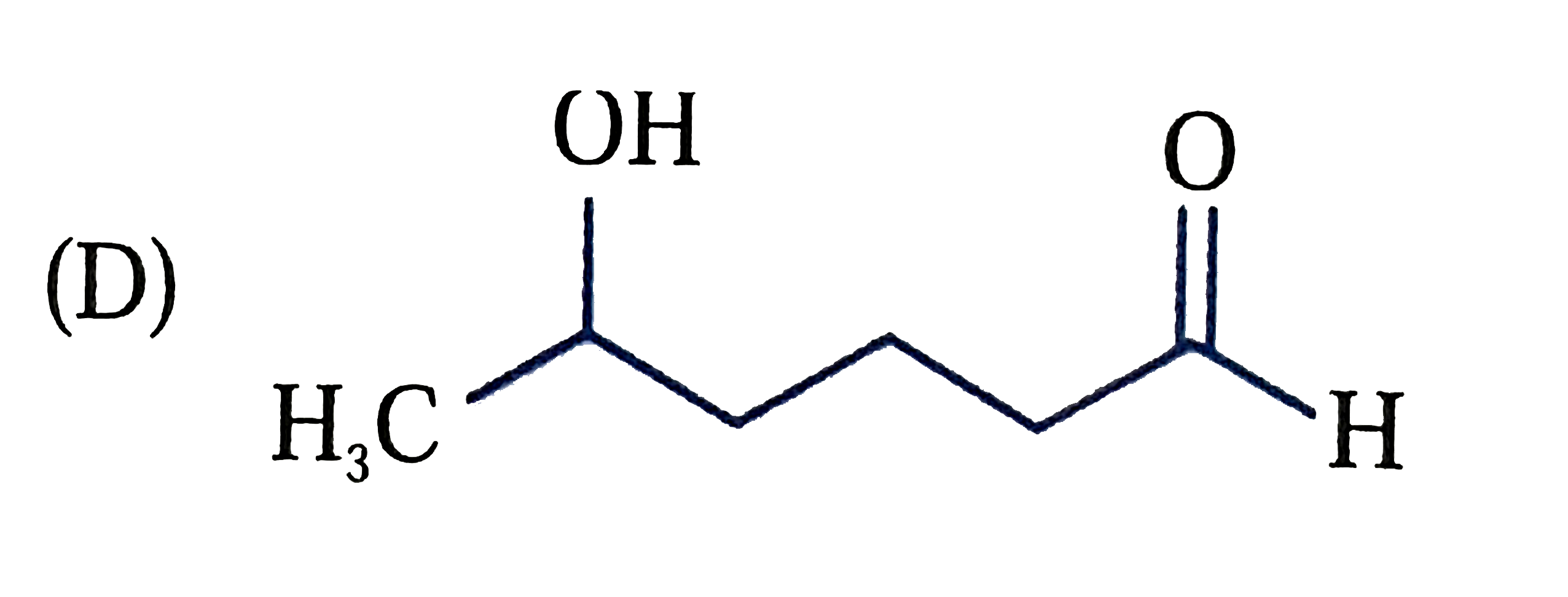End product of this reaction is




The correct Answer is:A
To determine the end product of the reaction given by the equation:
CH3−O||C−CH2−CH2−CH2−COOHNaBH4→H+/Δ→
we will follow these steps:
Step 1: Identify the Reactant
The reactant is a carboxylic acid with the structure:
CH3−O||C−CH2−CH2−CH2−COOH
This compound is 2-hexenoic acid.
Step 2: Understand the Role of NaBH4
Sodium borohydride (NaBH4) is a reducing agent. It will reduce the carbonyl group (C=O) of the carboxylic acid to a primary alcohol.
Step 3: Reduction Reaction
When NaBH4 is added to the carboxylic acid, the carbonyl carbon (C=O) is reduced to a hydroxyl group (-OH). The reaction can be summarized as follows:
RCOOH+NaBH4→RCH2OH+by-products
In this case, the carbonyl carbon of the carboxylic acid will be converted to a primary alcohol.
Step 4: Acid Work-Up
After the reduction, the reaction mixture is treated with an acid (H+) and heat (Δ). This step is often used to protonate the alcohol formed and to ensure that all the reactions are complete.
Step 5: Final Product
The end product after the reduction and acid work-up will be:
CH3−CH2−CH2−CH2−CH2−CH2−OH
This compound is 1-hexanol.
Final Answer
The end product of the reaction is 1-hexanol.
---
The reactant is a carboxylic acid with the structure:
CH3−O||C−CH2−CH2−CH2−COOH
This compound is 2-hexenoic acid.
Sodium borohydride (NaBH4) is a reducing agent. It will reduce the carbonyl group (C=O) of the carboxylic acid to a primary alcohol.
When NaBH4 is added to the carboxylic acid, the carbonyl carbon (C=O) is reduced to a hydroxyl group (-OH). The reaction can be summarized as follows:
RCOOH+NaBH4→RCH2OH+by-products
In this case, the carbonyl carbon of the carboxylic acid will be converted to a primary alcohol.
After the reduction, the reaction mixture is treated with an acid (H+) and heat (Δ). This step is often used to protonate the alcohol formed and to ensure that all the reactions are complete.
The end product after the reduction and acid work-up will be:
CH3−CH2−CH2−CH2−CH2−CH2−OH
This compound is 1-hexanol.
The end product of the reaction is 1-hexanol.
Topper's Solved these Questions
- CARBOXYLIC ACIDBOOK - MOTIONCHAPTER - CARBOXYLIC ACIDEXERCISE - Exercise - 2(LEVEL - 2)
65 Videos
- CARBOXYLIC ACIDBOOK - MOTIONCHAPTER - CARBOXYLIC ACIDEXERCISE - Exercise - 3
16 Videos
- CARBOXYLIC ACIDBOOK - MOTIONCHAPTER - CARBOXYLIC ACIDEXERCISE - Exercise - 4 (LEVEL - 2 )
22 Videos
- CARBONL COMPOUNDSBOOK - MOTIONCHAPTER - CARBONL COMPOUNDSEXERCISE - EXERCISE - 4 LEVEL -II
24 Videos
- CHEMICAL BONDING BOOK - MOTIONCHAPTER - CHEMICAL BONDING EXERCISE - EXERCISE -4 LEVEL-II
40 Videos
Similar Questions
Knowledge Check
End product of this conversion
CH3−O∣∣C−CH2−CH2−CH2−CO2H1.NaBH3−−−−−−−→2.H2O,H+ isA B
B C
C D
D
End product of this conversion
CH3−O∣∣C−CH2−CH2−CH2−CO2H1.NaBH3−−−−−−−→2.H2O,H+ isA B
B C
C D
D
CH3CH2CH2−O∣∣C−H+CH3−C≡CHNa,NH3(l)−−−−−−−→
A B
B C
C D
D
H2N−O∣∣C−CH2−CH2−O∣∣C−N3Δ−−→P
P is :
View SolutionThe major product formed in the reaction
CH3CH=CH−O∣∣C−CH3NaBH4−−−−−−−−→H2O,CH3OH is
View SolutionThe product of the reaction is CH3−CH2−O∣∣C−OAgBr2−−−−−→Δ Major product
View SolutionThe IUPAC name of CH3−OH∣CH−CH2−CH3∣CH−COOH is :−
View SolutionThe major product of the following reaction, (CH3)2CH−NH2∣CH−CH3HNO2−−−→ is
View Solution
